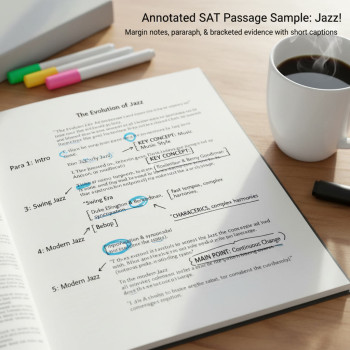Why a Weekly Power Hour Beats Random Studying
If you’re juggling classes, extracurriculars, homework, and a social life, the last thing you want is to add long, draining study sessions to the mix. That’s where the weekly “Power Hour” comes in: one concentrated, carefully planned 60-minute block each week that gives you the most return on your time. It’s not about cramming; it’s about practice with purpose. One focused hour, repeated consistently, will beat four hours of unfocused scrolling and half-hearted practice every time.
What Exactly Is a Power Hour?
Definition in plain language
A Power Hour is a single weekly 60-minute session you design to work on a specific SAT skill. It’s structured, timed, and review-heavy. Think of it as a weekly tune-up for your test-taking engine: you warm up, do high-quality practice, then review and adjust.
Why one hour? Why weekly?
- Consistency beats intensity. A habit that fits your schedule is a habit you keep.
- One hour is short enough to respect your time but long enough to do meaningful practice and review.
- Weekly repetition lets you rotate focuses—Reading one week, Math the next—so nothing gets ignored.
Benefits of a Weekly Power Hour
- Builds momentum: small, visible wins add up faster than sporadic marathons.
- Reduces burnout: predictable, limited commitment preserves energy for other responsibilities.
- Improves retention: spaced repetition and active review boost memory for test strategies and content.
- Focuses your weak points: targeted sessions make it easier to chip away at stubborn areas without feeling overwhelmed.
Designing Your Weekly Power Hour: A Step-by-Step Guide
Step 1 — Choose a clear, measurable goal
Start with a specific outcome. Instead of “work on reading,” try “improve sentence completion accuracy from 60% to 75% on medium-difficulty problems.” Clear targets make it easier to design an hour that produces measurable progress.
Step 2 — Pick a format and stick to it
Here are three practical formats you can rotate through:
- Skill Focus: 45 minutes of practice problems + 15 minutes of targeted review.
- Timed Mini-Section: Simulate a shortened, timed section (e.g., 25 minute reading set) + 35 minutes of error analysis and strategy.
- Mixed Drill: 15 minutes warm-up, 30 minutes mixed problems under time pressure, 15 minutes logging mistakes.
Step 3 — Break the hour into mini-units
Structure keeps your brain engaged. Try a 10/30/20 split: warm-up (10), focused practice (30), review and planning (20). Or use three 20-minute sprints if you like the Pomodoro vibe.
Sample Weekly Rotation: Four-Week Cycle
Rotating your weekly focus over a four-week cycle prevents tunnel vision and ensures full coverage across SAT sections. Below is a sample table that maps goals and metrics for each week.
| Week | Focus | Primary Goal | Measurement |
|---|---|---|---|
| Week 1 | Reading | Improve passage-scanning and question triage | Time per passage & accuracy on main idea questions |
| Week 2 | Math (Algebra) | Speed up algebraic manipulation under timed conditions | Average time per problem and error log review |
| Week 3 | Writing & Language | Master common grammar pitfalls and concision edits | Percent correct on paragraph-improvement items |
| Week 4 | Mixed/Practice Test | Simulate test timing and endurance (short form) | Composite score on timed mini-section |
Tools to Bring into Your Power Hour
- Timer: Use a visible timer to keep segments honest. A countdown creates focus.
- Official practice questions: Real practice beats approximations. If you have access to official SAT materials, prioritize them.
- Error log: A simple notebook or spreadsheet where you record question type, mistake reason, and pattern.
- Calculator & scratch paper for Math: Practice with the tools you’ll use test day.
- Annotation-ready printouts for Reading: Mark up passages as you would in a timed setting.

Minute-by-Minute Sample Power Hour: Math-Focused
Below is a step-by-step 60-minute plan that you can adapt to other sections. This example targets algebra and problem-solving questions.
0–10 minutes: Warm-up (concept refresh)
Skim a short list of formulas and mental math drills. Do 3 quick problems you know you can solve to build momentum. Example: simplify 3(x − 2) = 12; solve x = ? This gets the brain engaged without intimidating it.
10–40 minutes: Targeted timed practice
Complete 6–8 medium-difficulty algebra problems under strict timing (roughly 3–4 minutes each). Treat each problem like it matters: set your timer and don’t skip ahead until you finish. The pressure trains speed and decision-making.
40–60 minutes: Review + strategic planning
- For each incorrect or slow problem, write one sentence explaining the mistake (e.g., “I misread the variable isolation step”).
- Identify patterns: Are you getting tripped up by fractions, word problems, or careless arithmetic?
- Plan next steps: pick one small target for the next Power Hour based on the error log.
Sample Power Hour: Reading-Focused (Alternate)
0–10 minutes: Warm-up (vocabulary & focus)
Do a fast vocabulary drill and read a short paragraph, practicing annotation—circle the thesis, underline supporting evidence.
10–35 minutes: One timed passage
Tackle a single passage with associated questions under strict timing. Practice triaging questions: answer main idea and evidence questions first, detail questions later.
35–60 minutes: Deep review
Go back through incorrect answers and ask: did I misread the passage, misinterpret the question, or pick an answer because it sounded right? Note recurring traps and commit a targeted strategy for the next week (e.g., underline evidence sentences).

How to Use an Error Log Effectively
An error log is the single most underused tool among students. It turns random mistakes into an actionable roadmap. Keep at least three columns: Question Type, What Went Wrong, Fix to Practice. Over time you’ll see patterns—maybe you consistently miss geometry diagrams or stumble on parallel structure in Writing.
Tracking Progress: What to Measure
Measure both accuracy and time. For each Power Hour, track:
- Number of questions attempted
- Accuracy percentage
- Average time per question
- Number of recurring errors from your log
Use those metrics to tweak the next Power Hour. If your accuracy improves but time-per-question is still high, add more timed practice focused on speed. If time is fine but accuracy drops, shift to slower, careful review until patterns are fixed.
Common Pitfalls and How to Avoid Them
- Doing practice without review: If you never analyze mistakes, you’ll repeat them. Spend at least 15 minutes reviewing.
- Only practicing easy problems: Stretch your comfort zone occasionally. The SAT rewards being able to handle medium and hard questions reliably.
- Ignoring timing until test week: Make timing a consistent part of your practice so you don’t get blindsided by it on test day.
- Switching goals too often: Give a specific target at least 3–4 Power Hours before deciding it’s not working.
How Sparkl’s Personalized Tutoring Fits Naturally into Your Power Hour
If you want to amplify your Power Hour, consider pairing it with guided support. Sparkl’s personalized tutoring and benefits—like 1-on-1 guidance, tailored study plans, expert tutors, and AI-driven insights—can help you design Power Hours that are precisely aimed at your weak spots. A tutor can review your error log with you, suggest the best practice problems for your specific patterns, and model strategies in real time so your hour becomes even more efficient.
Scaling Up: When One Hour Isn’t Enough
As you improve, your Power Hour should evolve. Here’s how to scale safely without losing the benefits of focus:
- Increase intensity: replace some warm-ups with higher-difficulty questions.
- Add simulation segments: once a month, extend part of your hour into a 90-minute mini-section to build endurance.
- Use targeted micro-sessions during the week: keep the weekly hour as your anchor, and add two 20-minute drops for practice drills if your schedule allows.
Real-World Example: How a Student Turned One Hour a Week into Better Scores
Meet Alex, a busy junior who could only dedicate one solid hour per week to SAT prep. Instead of random problems, Alex built a rotating Power Hour: Week 1 reading, Week 2 algebra, Week 3 grammar, Week 4 mixed. Alex kept a simple error log and shared it with an online tutor for monthly check-ins. Within a few months, Alex noticed faster problem selection and fewer careless errors. What changed? The habit of targeted practice and deliberate review—not long sessions—created steady, reliable improvement.
Sample Quick Checklist: Your First Five Power Hours
- Power Hour 1: Baseline — take a timed mini-section and fill the first error log entries.
- Power Hour 2: Target one recurring mistake from the log and drill it.
- Power Hour 3: Rotate to a different section and repeat the baseline mini-test.
- Power Hour 4: Bring a timed mixed set and analyze whether cross-section skills are improving.
- Power Hour 5: Evaluate metrics, adjust your 4-week rotation, and consider adding a tutor check-in if you’re stuck.
| Session | Focus | Primary Action | Metric to Watch |
|---|---|---|---|
| Hour 1 | Reading | Timed passage & review | Accuracy on inference questions |
| Hour 2 | Math | Targeted algebra drills | Average time per problem |
| Hour 3 | Writing | Grammar patterns & concision practice | Percent correct on style edits |
Final Tips: Make Your Power Hour Stick
- Choose the same day and time each week so the hour becomes a non-negotiable appointment.
- Treat it like practice for the test day: full focus, no phone distractions, real timing.
- Celebrate small wins. Each time you cut average time per problem or fix a recurring error, that’s progress.
- Be flexible. If one approach isn’t working after a few cycles, try a different focus or bring in expert help.
Closing: Small Habit, Big Payoff
A weekly Power Hour is a sustainable, high-impact way to prepare for the SAT. It fits into busy lives, encourages deliberate practice, and gives you a concrete way to measure improvement. Whether you keep it solo, iterate with a study buddy, or combine it with Sparkl’s personalized tutoring and benefits—like 1-on-1 guidance, tailored study plans, expert tutors, and AI-driven insights—the key is consistency. Do the hour, review what went wrong, and make the next hour smarter. Over time, those focused 60 minutes become the habit that changes your score.
Start this week: set a timer, choose a clear goal, and commit to your first Power Hour. You’ll be surprised what one concentrated hour a week can do.















No Comments
Leave a comment Cancel